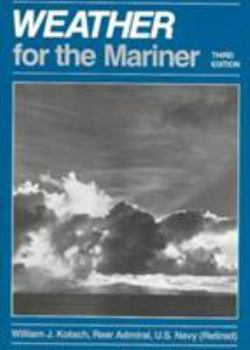Weather for the Mariner, 3rd Edition
Select Format
Select Condition 
Book Overview
This mariner's guide to the weather provides information on weather warnings and fronts, the Beaufort Scale, cloud formations, fog, storms, wind, waves and swells, barometer use, and simple... This description may be from another edition of this product.
Format:Hardcover
Language:English
ISBN:0870217569
ISBN13:9780870217562
Release Date:August 1983
Publisher:US Naval Institute Press
Length:334 Pages
Weight:1.85 lbs.
Dimensions:0.9" x 7.4" x 10.3"
Customer Reviews
2 ratings
Best explanation of weather at sea around
Published by Thriftbooks.com User , 18 years ago
The date on this book - over twenty years ago - on a technical subject immediately suggests that it probably is dated and has been superseded by better books. I took a chance and bought it anyway. It still is in print from the Naval Institute Press and that Press didn't seem to have anything comparable in print. Am I ever glad that I did. There are many books on understanding weather at sea but none as informative as this one. The discussions of clouds, low and high pressure systems, convection, wind shear, and even hurricanes are as thorough as you will find. Pressure differences and Coriolis force - force due to the earth's spinning on its axis - are fundamental building blocks for the book's explanation of weather. If you want to understand the weather and will be using that knowledge at sea, this is a great book. This book provides explanations of why weather develops, why the trade winds blow the way that they do and what to look for in weather developments. For example, Kotsch explains why daily showers happen over land during the day in areas such as Atlanta and why similar showers happen at night in areas such as the Virgin Islands. While not exactly earth shattering, I had noticed this big difference and wondered why it was different. Kotsch explains why you can use ocean swells to see where low pressure systems are, why wind direction changes over the course of the year in low-latitude areas such as the Virgin Islands and much more. The book was written as a textbook for use at the Naval Academy. You might be concerned that the book presupposes that the reader knows physics, but it does not. I unfortunately have forgotten the physics that I learned in high school, so I would have noticed if Kotsch took a lot of physics for granted. A major hole that I noticed because of the book's age is the discussion of how information about weather is acquired. Satellites are of course more important than in the 1980s and the system of bouys used to track the weather is much more extensive than in the 1980s. These deficiencies are not in terms of the understanding of weather though and are not a large part of the book. Perhaps the major deficiency for understanding the weather is the tentative discussion of hurricanes - they are much better understood now. No doubt a meteorologist could find more deficiencies, but I have not noticed errors that affect my practical understanding of the weather. As you can tell, I recommend this book very highly. It may not be the book for you though. If you are looking for rules of thumb to memorize about the weather, you will not like this book. Also, if you are looking for a simple overview, this is not the book for you. An overview of the basics that was informative for me was Weather at Sea by David Houghton.
A Mariner Must!
Published by Thriftbooks.com User , 23 years ago
This book breaks down the basics of marine weather for any novice sailor and brings the deep details in for the seasoned seaman. A nautical must.




